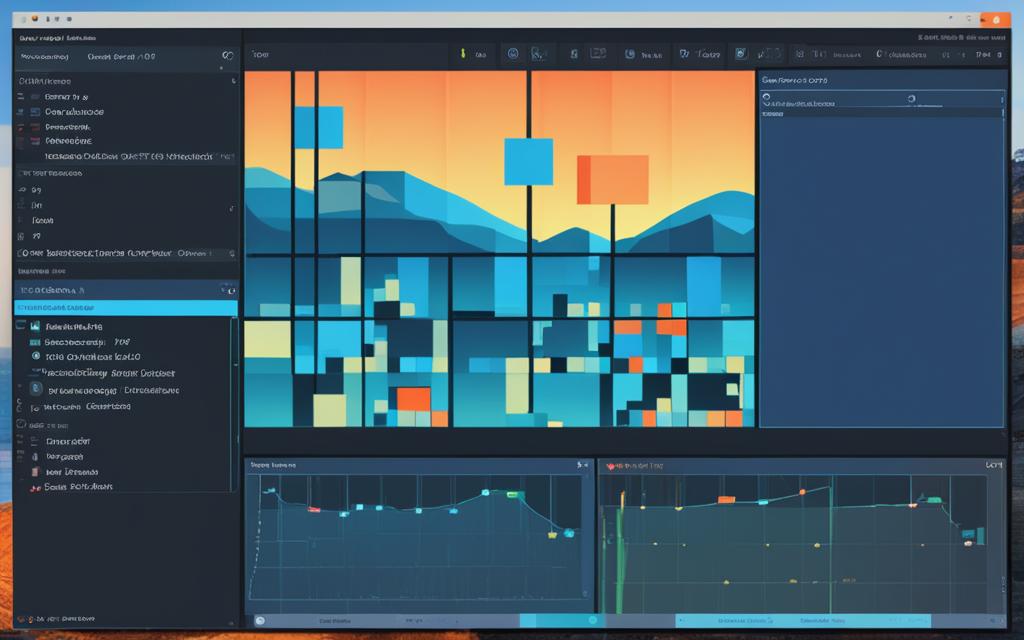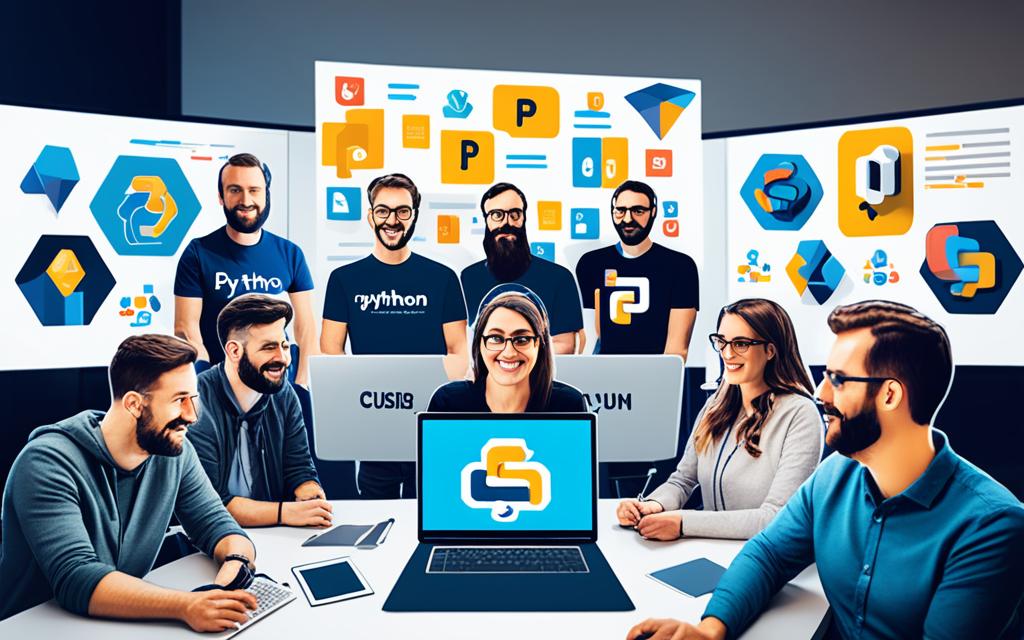As a Python developer, have you ever struggled with the complexities of traditional GUI frameworks, wishing for a simpler and more intuitive approach to building user interfaces? If so, you’re in for a treat. Introducing PySimpleGUI, the effortless GUI library that’s transforming the way Python developers create graphical applications.
In this article, we’ll embark on an exciting journey to explore the power and versatility of PySimpleGUI. You’ll discover how this remarkable library can help you design customizable, cross-platform GUIs with ease, empowering you to bring your Python projects to life in a way that’s both visually appealing and user-friendly.
But first, let me pose a question that might challenge your preconceptions: Can a GUI library truly be both simple and powerful? As you dive into the world of PySimpleGUI, you’ll find that the answer is a resounding yes. This library offers a unique balance of simplicity and flexibility, making it a game-changer for Python developers of all skill levels.
Introducing PySimpleGUI: The Effortless GUI Library for Python
As a Python developer, I understand the challenges of creating user-friendly graphical interfaces. Traditional GUI frameworks can often be complex and time-consuming to work with. That’s where PySimpleGUI comes in – a powerful Python library that simplifies the process of building GUIs.
PySimpleGUI is designed to be an intuitive and consistent interface for constructing GUI elements, such as buttons, input fields, and drop-down menus. By abstracting away the underlying complexities of GUI development, this Python GUI library empowers developers to focus on the core functionality of their applications, rather than getting bogged down in the technicalities.
One of the standout features of PySimpleGUI is its cross-platform compatibility. Whether you’re developing for Windows, macOS, or Linux, this tkinter alternative ensures your GUI applications will work seamlessly across different operating systems, simplifying the deployment process.
Additionally, PySimpleGUI offers a high degree of customizability, allowing developers to tailor the appearance and behavior of their GUI elements to suit the specific needs of their applications. This flexibility enables the creation of customizable gui experiences that truly cater to the user’s preferences.
In the upcoming sections, we’ll dive deeper into the world of PySimpleGUI, exploring its features, best practices, and real-world use cases. Prepare to be amazed by the simplicity and power of this transformative Python GUI library!
Why Choose PySimpleGUI Over Traditional GUI Frameworks?
As a Python developer, you’ve likely encountered the challenges of building user interfaces with traditional GUI frameworks like Tkinter or Qt. These frameworks can be powerful, but they often come with a steep learning curve and complex configuration requirements. This is where PySimpleGUI shines as a compelling alternative.
Simplicity and Ease of Use
One of the primary advantages of PySimpleGUI is its simplicity and ease of use. Unlike traditional GUI frameworks, PySimpleGUI abstracts away many of the technical details, allowing you to focus on building the user interface rather than dealing with complex configuration and setup. With its intuitive syntax and pre-built components, you can quickly create customizable and responsive GUIs without getting bogged down in the nitty-gritty of window management, event handling, and layout management.
Cross-Platform Compatibility
PySimpleGUI is designed to be cross-platform, meaning the same code can be used to create GUIs that run on Windows, macOS, and Linux. This simplifies the development and deployment process, as you don’t have to worry about writing separate code for different operating systems. With PySimpleGUI, your GUI applications can be easily shared and used across multiple platforms, saving you time and effort.
Whether you’re a seasoned Python developer or just starting out, PySimpleGUI offers a refreshing alternative to traditional GUI frameworks. Its simplicity, ease of use, and cross-platform compatibility make it an excellent choice for rapid GUI development and creating customizable user interfaces with minimal effort.
Getting Started with PySimpleGUI
If you’re a Python developer looking to create graphical user interfaces (GUIs) with ease, PySimpleGUI is the perfect library for you. Setting up PySimpleGUI is a breeze, and in this section, I’ll guide you through the installation process and the initial configuration steps to help you get up and running.
Installing PySimpleGUI
To install PySimpleGUI, you’ll first need to have Python installed on your system. Once you’ve got Python set up, you can install PySimpleGUI using the pip package manager. Simply open your terminal or command prompt and run the following command:
pip install pysimpleguiThis will download and install the latest version of PySimpleGUI on your machine, making it ready for you to use in your Python projects.
Configuring PySimpleGUI
With PySimpleGUI installed, you’re now ready to start building your first GUI. The library provides a simple and intuitive API, allowing you to create visually appealing interfaces with minimal code. Here’s a quick overview of the initial setup steps:
- Import the PySimpleGUI module at the beginning of your Python script:
- Define the layout of your GUI using PySimpleGUI elements, such as windows, buttons, and input fields.
- Create the GUI window and display it to the user using the
sg.Window()function. - Incorporate event handling and user interaction to make your GUI responsive and interactive.
import PySimpleGUI as sgWith these initial steps, you’ll be well on your way to creating your first PySimpleGUI application. In the next section, we’ll dive deeper into building your first GUI and explore the various features and capabilities of this powerful Python GUI library.
Building Your First GUI with PySimpleGUI
If you’re a Python developer looking to create sleek and user-friendly graphical user interfaces (GUIs), PySimpleGUI is the perfect library for you. In this section, we’ll dive into the process of building your first GUI using this powerful and intuitive Python gui library.
To get started, let’s create a simple window with a button and an input field. This will serve as the foundation for more complex user interface creation projects you’ll build in the future.
- First, import the PySimpleGUI module:
import PySimpleGUI as sg - Next, define the layout of your window using a list of lists. Each inner list represents a row in the window, and each element within the row is a UI element, such as a button or input field.
- Create the window using the
sg.Window()function, passing in the title and the layout you defined. - Enter the event loop, which will continuously monitor for user interactions and events.
- Inside the event loop, use the
window.read()function to get the event and values from the user’s interactions. - Finally, close the window using the
window.close()function.
In this example, we’ve created a window with a button and an input field. When the user clicks the button, the program will display the text they typed in the input field. This is just the beginning of what you can achieve with PySimpleGUI, a powerful and simple gui design library for Python developers.
Mastering PySimpleGUI’s Event-Driven Programming Model
As a Python developer, you’ll be delighted to discover the power of PySimpleGUI’s event-driven programming model. This intuitive library allows you to create interactive graphical user interfaces (GUIs) that respond dynamically to user actions, making your applications more engaging and user-friendly.
Understanding Events and Callbacks
At the heart of PySimpleGUI’s event-driven approach is the concept of events and callbacks. Events are triggered when a user interacts with your GUI, such as clicking a button, selecting a dropdown, or typing in a text field. By setting up callback functions, you can instruct PySimpleGUI to execute specific actions in response to these events, bringing your application to life.
For example, let’s say you have a button in your GUI that, when clicked, should display a message. You can define a callback function that will be called whenever the button is clicked, and within that function, you can display the desired message to the user. This event-driven design allows you to create seamless, responsive interfaces that cater to your users’ needs.
| Event-Driven Programming | Traditional GUI Frameworks |
|---|---|
| Intuitive and easy to learn | Typically more complex and require more boilerplate code |
| Promotes rapid GUI development | Often require more time and effort to set up and maintain |
| Encourages modular and scalable code structure | Can lead to more monolithic and less flexible designs |
By embracing PySimpleGUI’s event-driven programming model, you’ll unlock a world of possibilities for creating pysimplegui, simple gui design, and rapid gui development solutions. Get ready to build responsive and engaging GUIs that captivate your users and streamline their interactions with your Python applications.
Creating Customizable and Responsive GUIs
As a Python developer, one of the key benefits of using PySimpleGUI is its ability to help you create highly customizable and responsive graphical user interfaces (GUIs). In this section, we’ll dive deep into the layout techniques and best practices that will empower you to design visually appealing and user-friendly GUIs with ease.
Layout Techniques and Best Practices
At the heart of PySimpleGUI‘s flexibility lies its powerful layout system. This system allows you to arrange your GUI elements, such as buttons, text boxes, and dropdown menus, in a way that ensures your application remains responsive and visually appealing, even as the user interacts with it.
One of the key layout techniques you can leverage is grid-based layout. This approach enables you to divide your GUI into a grid of rows and columns, allowing you to precisely position your widgets and ensure a clean, organized appearance. By mastering grid-based layouts, you can create customizable GUIs that adapt seamlessly to different screen sizes and resolutions.
Another valuable layout technique is automatic window resizing. PySimpleGUI provides built-in support for dynamic window resizing, ensuring that your GUI elements adjust their size and position as the user resizes the application window. This feature helps you create responsive GUIs that provide a consistent user experience across a variety of devices and screen sizes.
Additionally, PySimpleGUI offers a range of layout options, such as the ability to create collapsible panels, tabbed interfaces, and custom GUI elements. These advanced layout techniques empower you to design simple GUI designs that seamlessly adapt to your users’ needs, ultimately leading to a more intuitive and engaging rapid gui development experience.

By leveraging the powerful layout capabilities of PySimpleGUI, you can create customizable GUIs that are not only visually appealing but also highly responsive to user interactions. This allows you to deliver a polished and user-friendly experience, making your Python applications truly stand out in the market.
Integrating PySimpleGUI with Other Python Libraries
As a versatile Python GUI library, PySimpleGUI shines when combined with other powerful tools in your Python toolbox. By seamlessly integrating PySimpleGUI with popular data analysis, visualization, and automation libraries, you can create robust, GUI-driven applications that streamline your workflows and take your projects to new heights.
One of the key advantages of PySimpleGUI is its ability to integrate with a wide range of Python libraries. Whether you’re working with data visualization tools like Matplotlib or Plotly, or automating tasks with libraries like Selenium or PyAutoGUI, PySimpleGUI can help you create intuitive user interfaces that enhance your productivity and the user experience.
For example, you can use PySimpleGUI to build a GUI-driven data visualization tool that leverages the power of Matplotlib or Plotly. By combining the simplicity of PySimpleGUI with the advanced charting capabilities of these libraries, you can create visually stunning and interactive dashboards that make data exploration and analysis a breeze.
Similarly, PySimpleGUI can be used to create user interface creation for your automation scripts, allowing users to easily interact with and control your automated workflows. This integration can unlock new levels of efficiency and productivity, making it easier than ever to streamline your daily tasks.
The flexibility and adaptability of PySimpleGUI make it a powerful tool for rapid GUI development within your broader Python ecosystem. By leveraging the synergy between PySimpleGUI and other Python libraries, you can create cutting-edge applications that seamlessly blend intuitive user interfaces with advanced functionality.
So, whether you’re working with data, automating tasks, or exploring new frontiers in Python development, consider the possibilities that PySimpleGUI can unlock when combined with your favorite Python tools. The opportunities for innovative and efficient GUI-driven applications are truly endless.
PySimpleGUI: The Key to Rapid GUI Development
As a Python developer, one of the most significant challenges I’ve faced is creating user interfaces (UIs) that are both visually appealing and functional. Traditional GUI frameworks can be complex and time-consuming to work with, often requiring extensive boilerplate code and a steep learning curve. However, PySimpleGUI, a powerful Python GUI library, has revolutionized the way I approach rapid GUI development.
PySimpleGUI is a game-changer when it comes to quickly prototyping and iterating on user interfaces for my Python applications. By abstracting away many of the low-level details of GUI programming, PySimpleGUI allows me to focus on the core functionality of my application, rather than getting bogged down in the complexities of UI design and implementation.
One of the key benefits of using PySimpleGUI is its cross-platform compatibility. Whether I’m developing for Windows, macOS, or Linux, PySimpleGUI provides a consistent and intuitive API that ensures my GUI applications work seamlessly across different operating systems. This flexibility is a game-changer, as it allows me to write my code once and deploy it to a wide range of user environments.
In addition to its simplicity and cross-platform support, PySimpleGUI also boasts a rich set of pre-built UI elements, ranging from buttons and text boxes to more advanced components like progress bars and file browsers. This extensive library of widgets saves me countless hours of manual UI development, enabling me to rapidly create visually appealing and functional interfaces for my Python applications.
Overall, PySimpleGUI has been a game-changer in my Python development workflow. By enabling me to rapidly prototype and deploy GUI applications, this powerful library has helped me bring my ideas to life faster and more efficiently than ever before. If you’re a Python developer looking to streamline your GUI development process, I highly recommend giving PySimpleGUI a try.
Data Visualization with PySimpleGUI
One of the standout features of the PySimpleGUI library is its ability to seamlessly integrate data visualization into your Python GUI applications. By leveraging popular data visualization libraries like Matplotlib and Plotly, PySimpleGUI empowers developers to create interactive, user-friendly dashboards and charts that elevate the overall data visualization experience.
Charting and Graphing Made Easy
With PySimpleGUI, embedding charts and graphs into your user interface creation has never been simpler. The library provides a straightforward interface for incorporating these visualizations, allowing you to quickly and effortlessly display complex data in a visually appealing manner. Whether you’re creating line charts, bar graphs, or scatter plots, PySimpleGUI ensures that the process is as rapid GUI development as possible, enabling you to focus on the core functionality of your application.
By combining the power of these data visualization tools with the flexibility and ease-of-use of PySimpleGUI, you can craft intuitive and engaging data exploration experiences for your users. The seamless integration between the libraries allows for a seamless user experience, where the visualizations become a natural extension of your Python GUI application.

Ultimately, PySimpleGUI empowers developers to bring data-driven insights to the forefront, making it easier than ever to incorporate data visualization into your Python GUI projects. Whether you’re building a dashboard, a reporting tool, or a data analysis application, PySimpleGUI’s robust support for charting and graphing can elevate your user interface creation and drive impactful rapid GUI development.
Debugging and Testing PySimpleGUI Applications
As a Python developer, I understand the importance of writing robust, reliable code. When it comes to building GUI applications with PySimpleGUI, a popular python gui library, proper debugging and testing practices are crucial. In this section, I’ll share some valuable insights on how to effectively debug and test your PySimpleGUI applications, ensuring they are stable, user-friendly, and ready for deployment.
Debugging PySimpleGUI: Your Toolkit
Debugging is an essential part of the software development process, and PySimpleGUI provides several tools to help you identify and fix issues in your code. One of the most powerful debugging features is the built-in print statement, which allows you to quickly output values and track the flow of your program. Additionally, you can leverage the PySimpleGUI debugger, which offers a user-friendly interface for stepping through your code and inspecting variables.
Testing PySimpleGUI Applications
To ensure the long-term stability and reliability of your PySimpleGUI applications, it’s important to implement a comprehensive testing strategy. This includes writing unit tests to validate the functionality of individual components, as well as integration tests to ensure your GUI seamlessly interacts with other parts of your application. By integrating your PySimpleGUI code into a broader testing framework, you can catch bugs early and maintain a high level of code quality.
Debugging and testing may seem like a daunting task, but with the right tools and strategies, you can streamline the process and create simple gui design that are both visually appealing and highly functional. By mastering these essential techniques, you’ll be well on your way to building exceptional PySimpleGUI applications that stand the test of time.
PySimpleGUI in Action: Real-World Use Cases
As a Python developer, I’ve been consistently impressed by the versatility and real-world applications of the PySimpleGUI library. This powerful Python GUI library has found its way into the toolkits of developers across various industries, and the success stories are truly inspiring.
Unlocking Data Visualization Potential
One of the standout use cases I’ve encountered is the integration of PySimpleGUI with data visualization tools. Developers have leveraged PySimpleGUI to create custom data visualization GUIs, empowering users to interact with complex datasets and gain valuable insights through intuitive user interface creation. These applications have streamlined data analysis workflows and made it easier for non-technical stakeholders to engage with vital information.
Automating Workflows with PySimpleGUI
Another impressive real-world use case of PySimpleGUI is in the realm of automation. I’ve seen developers utilize this Python GUI library to build custom GUIs for automating repetitive tasks, from file management to system administration. These success stories showcase how PySimpleGUI can transform manual, time-consuming processes into efficient, user-friendly applications.
| Industry | Use Case | Benefits |
|---|---|---|
| Data Analytics | Interactive data visualization dashboards | Improved data accessibility and insights for non-technical users |
| Software Engineering | GUI-based prototyping and testing tools | Faster development, better user feedback, and iterative improvements |
| IT Operations | Automated system management and monitoring applications | Streamlined workflows, reduced errors, and increased productivity |
These are just a few of the inspiring real-world use cases I’ve seen for PySimpleGUI. As I continue to explore the capabilities of this remarkable Python GUI library, I’m excited to see how developers will continue to push the boundaries and find new and innovative ways to leverage its power.
Extending PySimpleGUI: Customization and Advanced Features
As a Python developer, I’ve been thoroughly impressed with the versatility of the PySimpleGUI library. While the out-of-the-box features are already quite robust, the true power of this GUI toolkit lies in its ability to be customized and extended to suit our specific needs. In this section, we’ll explore the advanced capabilities of PySimpleGUI, empowering us to create truly unique and tailored graphical user interfaces.
One of the most exciting aspects of PySimpleGUI is the opportunity to develop custom widgets. By leveraging the underlying GUI frameworks, such as Tkinter, Qt, or WxPython, we can seamlessly integrate our own specialized components into our applications. This allows us to create user interfaces that are not only visually appealing but also deeply integrated with the core functionality of our programs.
Additionally, PySimpleGUI’s flexibility extends beyond custom widgets. We can seamlessly integrate third-party libraries and tools, unlocking a world of possibilities. From data visualization to machine learning, the integration capabilities of PySimpleGUI make it a powerful hub for rapid GUI development.
To further enhance our PySimpleGUI experience, we can delve into the advanced features of the library, such as event handling, multi-window management, and keyboard/mouse interactions. These powerful techniques enable us to create truly responsive and interactive graphical applications that provide an exceptional user experience.
By exploring the customization and advanced features of PySimpleGUI, we can unlock the true potential of this remarkable Python GUI library. Whether you’re building a simple utility or a complex enterprise-level application, the tools and techniques covered in this section will empower you to take your GUI development to new heights.
Unlocking the Power of Custom Widgets
One of the key advantages of PySimpleGUI is its ability to integrate seamlessly with the underlying GUI frameworks. This allows us to create custom widgets that are tailored to our specific needs. By leveraging the flexibility of Tkinter, Qt, or WxPython, we can design unique user interface elements that enhance the overall user experience.
- Develop specialized input fields, buttons, or data visualization components
- Integrate external libraries and tools to expand the functionality of our GUI
- Implement complex layouts and visual styles to achieve the desired aesthetic
Mastering Event-Driven Programming with PySimpleGUI
At the heart of PySimpleGUI’s advanced features lies its event-driven programming model. By understanding and leveraging the library’s event handling capabilities, we can create highly responsive and interactive graphical applications.
- Capture and respond to user actions, such as button clicks, key presses, or mouse movements
- Implement dynamic updates and real-time feedback within our GUI
- Seamlessly integrate event-driven logic with the core functionality of our Python programs
| Feature | Description | Benefit |
|---|---|---|
| Custom Widgets | Develop specialized user interface elements tailored to your needs | Enhanced user experience and increased functionality |
| Third-Party Integrations | Seamlessly integrate external libraries and tools into your PySimpleGUI applications | Expanded capabilities and access to a wide range of functionalities |
| Advanced Event Handling | Leverage the event-driven programming model to create highly responsive and interactive GUIs | Improved user engagement and dynamic application behavior |

By exploring the customization and advanced features of PySimpleGUI, you’ll unlock a world of possibilities in your Python GUI development journey. Whether you’re looking to create unique user interface elements, integrate external tools and libraries, or harness the power of event-driven programming, this remarkable library has the tools to help you succeed.
The Future of PySimpleGUI: What’s Next?
As I continue my journey with PySimpleGUI, a captivating Python GUI library, I’m excited to explore the potential future developments and enhancements that lie ahead. The ongoing efforts of the passionate developer community behind this project are truly inspiring, and I can’t wait to see how PySimpleGUI will evolve to meet the growing needs of Python enthusiasts like myself.
One of the most promising areas for PySimpleGUI’s future is the introduction of cutting-edge features that will streamline the creation of modern, responsive, and visually appealing user interfaces. I anticipate the incorporation of advanced layout techniques, seamless integration with popular data visualization libraries, and the expansion of cross-platform support to cater to an even wider range of user preferences and deployment scenarios.
Moreover, I’m eager to witness the continued refinement of PySimpleGUI’s event-driven programming model, making it even more intuitive and efficient for developers to build interactive and responsive applications. The prospect of enhanced debugging tools, comprehensive documentation, and a growing community of contributors dedicated to the project’s success fills me with excitement for what the future holds.
FAQ
What is PySimpleGUI?
PySimpleGUI is a Python library that simplifies the creation of graphical user interfaces (GUIs) for your applications. It provides a straightforward and consistent interface for building customizable and cross-platform GUIs, making it easier for developers to create user-friendly applications.
Why should I choose PySimpleGUI over traditional GUI frameworks?
PySimpleGUI offers several key advantages over traditional GUI frameworks like Tkinter or Qt. It is known for its simplicity and ease of use, allowing you to focus on building the user interface rather than dealing with complex configuration and setup. Additionally, PySimpleGUI is designed to be cross-platform, meaning the same code can be used to create GUIs that run on Windows, macOS, and Linux, simplifying the development and deployment process.
How do I get started with PySimpleGUI?
To get started with PySimpleGUI, you’ll need to have Python installed on your system. PySimpleGUI is available through the Python Package Index (PyPI), so you can install it using the pip package manager. Once installed, you can start using PySimpleGUI in your Python scripts, and we’ll walk through the basic setup and configuration steps to help you get up and running.
How do I create my first GUI with PySimpleGUI?
In the “Building Your First GUI with PySimpleGUI” section, we’ll dive into creating your first GUI using PySimpleGUI. We’ll start with a simple example that demonstrates how to create a window, add elements like buttons and input fields, and handle user interactions. By the end of this section, you’ll have a solid understanding of the basic building blocks of a PySimpleGUI application, setting the stage for more advanced GUI development.
How does PySimpleGUI’s event-driven programming model work?
PySimpleGUI follows an event-driven programming model, where user interactions with the GUI trigger specific actions or events. In the “Mastering PySimpleGUI’s Event-Driven Programming Model” section, we’ll explore how to handle these events and set up callback functions to respond to user input. You’ll learn how to create interactive GUIs that react dynamically to user actions, laying the foundation for more complex and responsive applications.
Can I customize and make my GUIs responsive with PySimpleGUI?
Yes, one of the strengths of PySimpleGUI is its ability to help you create customizable and responsive GUIs. In the “Creating Customizable and Responsive GUIs” section, we’ll dive into layout techniques and best practices for designing your GUI elements. You’ll learn how to use PySimpleGUI’s layout system to arrange your widgets, handle dynamic resizing, and ensure your GUI remains visually appealing and user-friendly.
How can I integrate PySimpleGUI with other Python libraries?
PySimpleGUI is designed to be a versatile tool that can be integrated with a wide range of other Python libraries. In the “Integrating PySimpleGUI with Other Python Libraries” section, we’ll explore how to combine PySimpleGUI with popular data analysis, visualization, and automation tools, allowing you to create powerful GUI-driven applications that seamlessly integrate with your existing Python workflows.
How can PySimpleGUI help me with rapid GUI development?
One of the key benefits of PySimpleGUI is its ability to enable rapid GUI development. By abstracting away many of the complexities associated with traditional GUI frameworks, PySimpleGUI allows you to quickly prototype, iterate, and deploy user interfaces for your Python applications. In the “PySimpleGUI: The Key to Rapid GUI Development” section, we’ll discuss how PySimpleGUI can help you accelerate your development workflow and get your ideas in front of users faster.
Can I use PySimpleGUI for data visualization?
Yes, PySimpleGUI excels at enabling data visualization within your GUI applications. In the “Data Visualization with PySimpleGUI” section, we’ll explore how to integrate PySimpleGUI with popular data visualization libraries like Matplotlib and Plotly, allowing you to create interactive charts, graphs, and dashboards that seamlessly fit within your GUI. You’ll learn how to easily embed these visualizations into your PySimpleGUI layouts, providing users with a comprehensive and user-friendly data exploration experience.
How can I debug and test my PySimpleGUI applications?
Debugging and testing are essential steps in the process of building robust PySimpleGUI applications. In the “Debugging and Testing PySimpleGUI Applications” section, we’ll discuss best practices and techniques for effectively debugging your PySimpleGUI code, as well as strategies for writing unit tests and integrating your GUI applications into a broader testing framework. These tools and methods will help you ensure your PySimpleGUI-powered applications are stable, reliable, and ready for deployment.
What are some real-world use cases for PySimpleGUI?
In the “PySimpleGUI in Action: Real-World Use Cases” section, we’ll explore real-world use cases and success stories from the PySimpleGUI community. You’ll see how developers across various industries have leveraged PySimpleGUI to build custom GUIs for data analysis, automation, prototyping, and more. These inspiring examples will help you envision the possibilities and spark ideas for your own PySimpleGUI-powered projects.
Can I customize and extend PySimpleGUI’s features?
Yes, while PySimpleGUI provides a wealth of out-of-the-box features and functionality, the library also offers opportunities for customization and advanced usage. In the “Extending PySimpleGUI: Customization and Advanced Features” section, we’ll dive into techniques for extending PySimpleGUI, such as creating custom widgets, integrating third-party libraries, and leveraging the underlying GUI frameworks (Tkinter, Qt, WxPython) to unlock even more powerful GUI capabilities. These advanced topics will help you tailor PySimpleGUI to your specific needs and take your GUI development to the next level.
What’s the future of PySimpleGUI?
As PySimpleGUI continues to evolve, it’s exciting to consider the potential future developments and enhancements that may come. In the “The Future of PySimpleGUI: What’s Next?” section, we’ll explore the roadmap for PySimpleGUI, discussing the ongoing efforts of the developer community, potential new features, and the long-term vision for the library. This will give you a glimpse into the exciting possibilities that lie ahead for PySimpleGUI and inspire you to stay engaged with the project as it continues to grow and improve.






